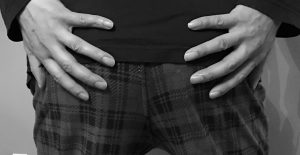Introduction:
Hemorrhoids encompass a range of conditions, including internal and external hemorrhoids, anal tags, thrombosed hemorrhoids, and mixed hemorrhoids. Internal hemorrhoids are classified from I to IV based on the degree of prolapse. In addition to causing discomfort, pain, bleeding, and prolapse, hemorrhoids can lead to complications like thrombosis, anemia, and infection. Furthermore, many hemorrhoid patients also present with comorbidities such as anal fissures, fistulas, or anal warts. Given the diversity of these conditions, it’s essential for a comprehensive hemorrhoid clinic to offer a variety of treatment modalities and options to address each patient’s unique needs and deliver thorough care.
Relying on a single treatment modality for hemorrhoids, regardless of their severity, type, or associated anorectal conditions, often results in subpar outcomes and inadequate quality of care.
 The reality is that there is no one-size-fits-all solution for hemorrhoids or their associated anorectal symptoms. Specialized hemorrhoid clinics should provide multiple treatment modalities featuring state-of-the-art technologies to effectively manage hemorrhoids and related ailments.
The reality is that there is no one-size-fits-all solution for hemorrhoids or their associated anorectal symptoms. Specialized hemorrhoid clinics should provide multiple treatment modalities featuring state-of-the-art technologies to effectively manage hemorrhoids and related ailments.
Treatment for Internal Hemorrhoids:
Dr. Shu has developed an effective treatment protocol for patients with the most common hemorrhoids ranging from grade 2 to 3, combining initial banding treatments for prolapsed hemorrhoidal areas with infrared coagulation for milder cases.
Treatment of External Hemorrhoids:
Note: One Stop Medical Center provides the service of hemorrhoid care. We have two office locations in Edina, Minnesota, and Casselberry, Florida. If you are interested in hemorrhoid care, Please fill out the online registration first, we will call you in 2 business days, or please call us at 1-888-992-0019 if any questions.
 Understanding Anal Tags
Understanding Anal Tags Hemorrhoids are swollen blood vessels in the rectum or anus that can cause pain, itching, bleeding, and discomfort during bowel movements. They can be internal (inside the rectum) or external (outside the anus). Lifestyle factors, constipation, pregnancy, and genetics are common contributors to their development.
Hemorrhoids are swollen blood vessels in the rectum or anus that can cause pain, itching, bleeding, and discomfort during bowel movements. They can be internal (inside the rectum) or external (outside the anus). Lifestyle factors, constipation, pregnancy, and genetics are common contributors to their development.
 As the venous complex of an internal hemorrhoid becomes varicose and continues to enlarge, it bulges into the anal canal and loses its normal anchoring, becoming a prolapsing internal hemorrhoid. The prolapsing hemorrhoid usually returns into the anal canal or rectum on its own, or can be pushed back inside using one’s finger, but usually prolapses again after the next bowel movement. In the anal canal, a hemorrhoid is exposed to movement caused by passing stool, particularly hard stools that can cause bleeding and sting pain. The painless rectal bleeding with bright red blood is a common symptom of internal hemorrhoids. The rectal mucosal lining that has been pulled down secretes mucus and moistens the anus and its surrounding skin, while the stool itself can also leak onto the anal skin. Itchiness often occurs as a result of this dual presence of stool and moisture.
As the venous complex of an internal hemorrhoid becomes varicose and continues to enlarge, it bulges into the anal canal and loses its normal anchoring, becoming a prolapsing internal hemorrhoid. The prolapsing hemorrhoid usually returns into the anal canal or rectum on its own, or can be pushed back inside using one’s finger, but usually prolapses again after the next bowel movement. In the anal canal, a hemorrhoid is exposed to movement caused by passing stool, particularly hard stools that can cause bleeding and sting pain. The painless rectal bleeding with bright red blood is a common symptom of internal hemorrhoids. The rectal mucosal lining that has been pulled down secretes mucus and moistens the anus and its surrounding skin, while the stool itself can also leak onto the anal skin. Itchiness often occurs as a result of this dual presence of stool and moisture.



